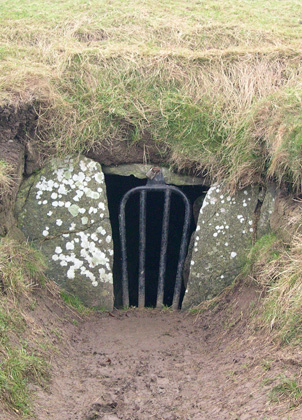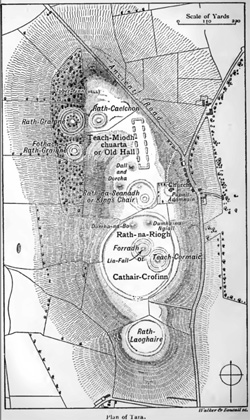As you walk this historic hill called Tara, it is well to keep in mind that it is …..
A Royal Place
In prehistory and historic times 142 Kings are said to have reigned in the name of Tara. The coronation stone called The Lia Fail or Stone of Destiny has rested here down the ages. And it was here that the most powerful of Irish Kings held their great inaugural feasts and were approved by Earth Mother Goddesss Maeve
A Sacred Place
In ancient Irish religion and mythlogy, Tara was revered as a dwelling of the gods and an entrance place to the otherworld of eternal joy and plenty where no mortal ever grew old. In the legends of St Patrick’s mission to Ireland he is said to have first come to Tara to confront the ancient religion in its most powerful sight.

A Celtic Place
Tara is one of the largest complexes of Celtic monuments in all of Europe. In reading its landscape we are transported back in time to when the first settlers came here 6000 years ago. They and the Celts who followed them chose Tara as a very special site.
Tara is now government owned. entry to its 100 acres is free – but it was not always this way. By a unique concession, previous private owners of the hill had the right to collect six old pence at the gate right up until the 1970′s.
One nineteenth century owner of Tara was British Prime Minister Lord John Russell who inherited the sight as part of his Irish estates in 1839. His southern part of the hill became the property of the state in 1952. The government then bought the northern 50 acres in 1974.
Although little over 500 ft in height, Tara still commands the surrounding countryside. One origin of Tara’s name is ‘Teamhair’ – place of great prospect. On a clear day it is claimed that from Tara it is possible to see half the counties of Ireland. To the north east the view reaches all the way to the mountains of Mourne. Closer is the Hill of Slane where St Patrick is said to have lit his Pascal fire prior to making his way to Tara in the year 433 A.D. To the east can be seen The Hill of Skryne where St Columcille founded a monastery in the 6th century.
When you enter the Hill of Tara site through the entrance gate the first structure you will come to a statue of St Patrick followed by the church and churchyard. The present church building and churchyard wall date from 1822. There were 2 previous churches on the hill – the first one was built in the 13th century. A much larger church succeeded it. Part of this second church’s outer wall can still be seen near the top of the steps in the churchyard. The earliest grave stones here date from the 17th century. A memorial stone of the local Dillan family in the church itself is dated 1595.
The present church building was deconsecrated in 1991 when it became the responsibility of the OPW. However once a year it reverts to its previous use for a service on St Patricks day.
 The church now houses an interpretive centre where a sound and picture presentation on Tara’s history is given two or three times an hour during the tourist season.
The church now houses an interpretive centre where a sound and picture presentation on Tara’s history is given two or three times an hour during the tourist season.
To the right at top of the stairs in the churchyard there are two stones – remnants of a time when there were many stone monuments on Tara. The taller of these two remaining stones is thought to feature a figure of the celtic fertility god Cernunnos.


